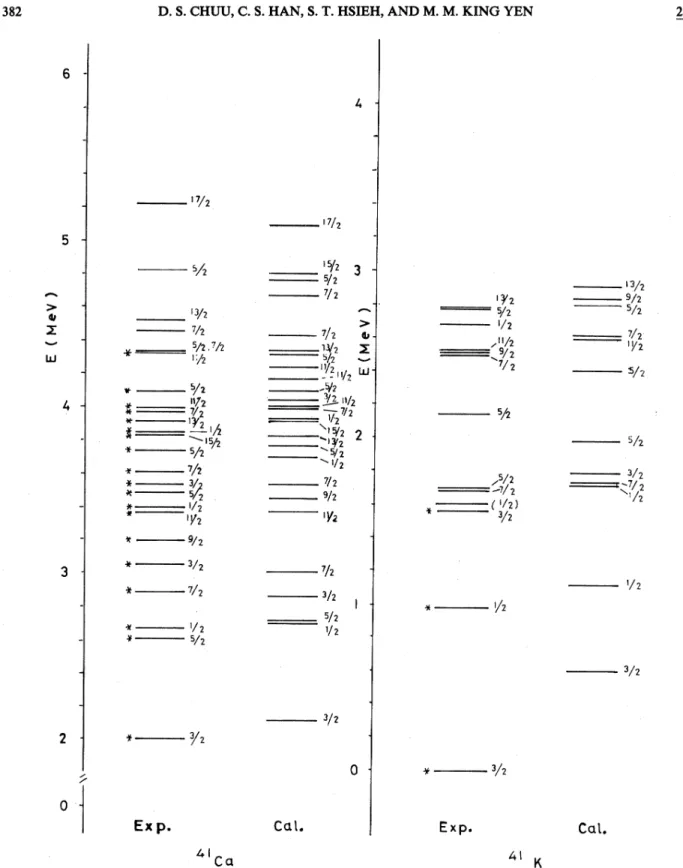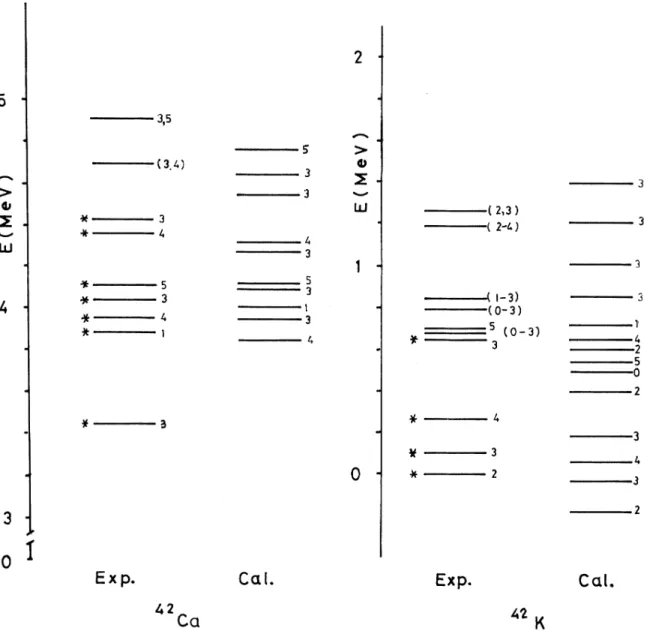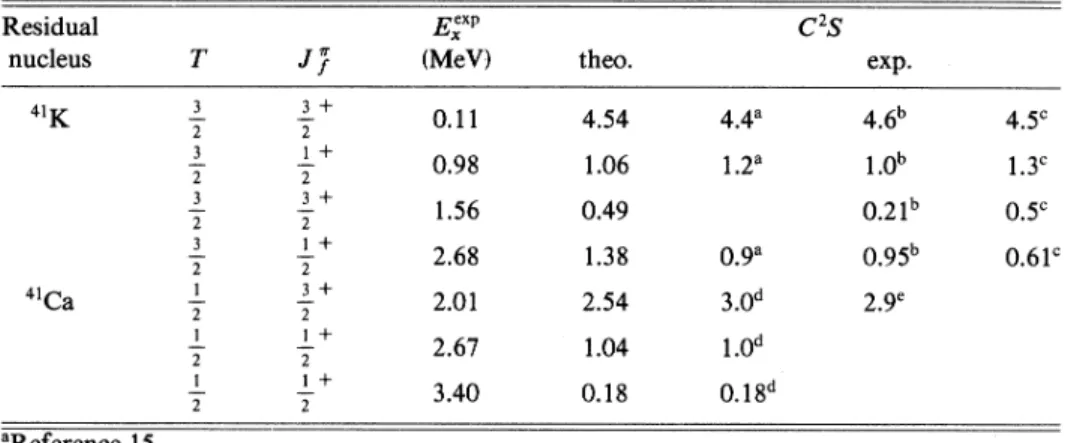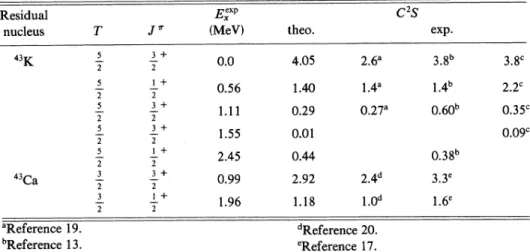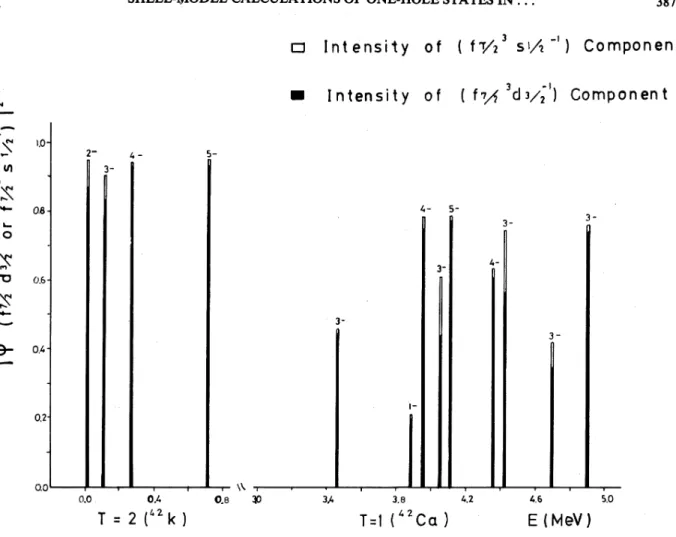Shell-model
calculations
of
one-hole states
inthe
nucleiof
A=41
—
43
D.
S.
Chuu andC. S.
HanDepartment
of
Electrophysics, National Chiao Tu-ng University, Hsinchu, Taiwan, Republicof
ChinaS.
T.
HsiehDepartment
of
Physics, National Tsing Hua University, Hsinchu, Taiwan, Republicof
ChinaM. M.
King YenDepartment
of
Nuclear Engineering, National Tsing Hua University, Hsinchu, Taiwan, Republicof
China (Received 17 February 1982)The one-hole states ofA
=41
—
43nuclei are calculated with amodel space spanning the (f7/2p3/2)" (d3/2si/2) ' configurations. The two-body effective interaction is assumed tobe the modified surface-delta type. Energy spectra and spectroscopic factors are calculated and compared with the observed values. Satisfactory results are obtained.
NUCLEAR STRUCTURE A
=41
—
43,calculated effective interaction, energy spectra, spectroscopic factors.I.
INTRODUCTIONThe nuclei in the
lf-2p
shell have long beenof
in-terest to both experimental and theoretical nuclear physicists. Extensive studies have been done' 2 forthe normal parity states
of
the nuclei in this region.For
the non-normal parity levels, however, the situ-ation isless well understood. This paper will give a systematic studyof
the one-hole states in the mass regionof
A=41
—
43 within the frameworkof
theshell model. The particles are assumed
to
be distri-buted in the 1f7/2 and 2p3/2 orbitals and one hole isassumed tobe in the 1d3&z or2s&&q orbital.
A least-squares fit calculation on the non-normal parity states in
lf-2p
shell nuclei has been per-formed by Dieperink and Brussard within the descriptionof
the (lf7/2)"(ld3/2) ' configuration. In their results, only the low-lying energy levels can be reproduced and the calculated transition rates are not in agreement with the observed values. This discrepancy isdue to the fact that the configuration space they used is too small. Later, Hsieh etal.
'
calculated the non-normal parity states for thenu-clei in the
A=39
—
41 region by expanding themodel space to include the complete
(lf-2p)
shelland single-hole states in the (2s,ld) shell. Some dis-tinct improvements were obtained. The spectro-scopic factors and electromagnetic (EM) transition rates obtained were in reasonably good agreement
with experimental data.
For
the heavier massre-gion
A=42,
the extended model space has not yetbeen employed. Lawson and Muller-Arnke have studied the magnetic moment
of
the(3/2)
i+ state in Scand found that this state does not have apure(f
7/2) (d3/2 ) ' configuration. The lifetime andmagnetic moment can only be accounted for
simul-taneously by extending the model space to include about
10% of
the (f7/2) (si/2) ' admixture. The importanceof
the s~&z hole state can also be seen inthe spectrum
of
potassium isotopes; thel=0
hole strength steadily decreases in energy with increasing mass. From the/=1
single-particle strengthob-served for levels around 1 MeV in Ca, it is clear that the contribution
of
thep3/2 orbital for nucleiof
A &42 is also important. Johnstone recently re-ported calculations for the one-hole states in
potas-sium isotopes
(A=40
—
46) using a model space based on the(f
7/2~P3/2 )"(d3/2,$1/2)configuration. The matrix elements
of
the residual interaction are treated as free parameters which are determined by aleast-squares fit tothe observeden-ergy levels; good agreement is achieved in his re-sults. The works mentioned above encourage us to reinvestigate the one-hole states in the mass region
of
A=41
—
43.
A better systematic prediction is ex-pectedif
we expand the original model space (lf7/2,ldll/2 ') to include the active particle orbit 2p3&z and the active hole orbit 2s&&z.It
is hopedthat so doing, and considering only one-particle, in-stead
of
multiparticle, excitation from the 1d3/p oron the energy level calculation is expected to be small. The reason is as follows. The spurious states are distributed in the space within laic@
of
excita-tion, and our model space contains only partof
them. Furthermore, the intensitiesof
the low-lyingstates are rather concentrated in certain components
of
the basis states. Thus, the effectof
spurious states is negligible except in the calculationof
El
transition rates, which weare not interested in.II.
THEMODELIn this calculation, we consider the one-hole states
of
A=41
—
43 nuclei; the nucleus Ca is as-sumed to be the core. The active nucleons are dis-tributed in the lf7/p and 2p3/2 orbitals and oneac-tive hole is allowed in the 1d3/2 or2s&/2 orbital. In
order to obtain a model space
of
manageable size,we neglect the 2p~/2 orbital. This should not
intro-duce significant errors since the 2p&/2 lies about 4 MeV above the lf7/2 orbital. Also, according to the Kuo-Brown matrix elements, the f7/2 p'[/2
in-teraction is very weakly attractive. The omission
of
the lds/2 and 1f5/2 orbitals from the model space isquite reasonable because the splitting
of
theob-served single-particle levels
of
2s~/2-1d5/2 and1
f
5/2-2p3/p are much larger than thoseof
ldll/g-2s)/2 and 2p3/2 lf7/2 Within this model space we diagonalize an effective one-body plus
two-body Hamiltonian. We identify the resulting
eigenvalues with observed energy levels and use the eigenvectors as wave functions to calculate various observables.
The effective Hamiltonian in this space has the orm
H =Ho+Hpp+Hgp
.
Here Ho is the Hamiltonian
of
the single particle in the effective fieldof
the core. The single-particleenergies for active orbitals were chosen initially from the observed single-particle spectra
of
the masses39,
40, and41.
H&& represents the effective two-body interactions between the particles in the1f7/2 and 2p3/2 orbitals, while II~~ represents the effective interaction between the hole in the 1d3/2
or 2s&/2 orbital and the particle in the lf7/2 arid 2pq/2 orbitals. The two-body effective interactions
are assumed tobe the modified surface delta form
VJ.
=4rrAr(Q,
J)+Br,
T=0,
1,
With this prescription we carry out a least-squares fit calculation on the energy spectra
of
'"
Ca,'
'K,
andSc. For
the inputexperi-mental data, we include in principle all the available
low-lying levels with reliable
J
assignments up tothe point that the first level with an uncertain
J"
assignment appears. Forty-three energy levels are included in the calculation. The eight interaction strengths (AO,A~,BO, B~)zz and (AO,A„BO,
B~)~~and the ld&/2-2s&/2, lf7/2-ld&/2, and 2ps/2-id&/r
single-particle energy spacings are varied until the discrepancy between the calculated and observed
en-ergy levels is minimized. The overall rms deviation is
0.
26 MeV. The best-fit interaction strengths and single-particle energy spacings are listed in TableI.
The center-of-mass spurious states have not been re-moved in the calculation.
A. Energy spectra
TABLE
I.
The particle-particle and hole-particle in-teraction strengths and the single-particle energy spacings (inMeV). hp—
1.73—
0.57—
0.03 0.02 Bp 2.20—
2.02—
0.66—
0.32 1tg3/2 2s~/z 1f7/2 1d3/2 2p3/2 183/2 1.68 5.71 6.66The calculated energy spectra produced by the
hest fit parameters together with the observed
values are shown in Figs. 1
—
3.
The experimental data are taken from Endt and Leun. Those levelsthat are included in the least-squares fits are marked with an asterisk. The excitation energies
of
the one hole states were made to fitthe observed en-ergies relative to the ground state energies
of
the nuclei withA=41
—
43.
Since we are only con-cerned with the energy spacings relative to the ground states in our calculation, itis hoped that the adjustable single-particle energies may absorb the discrepancy due to the effectof
neglecting the three-hole configuration.6
4 I72 I7/2 3 I 3/2 7/2 5/2,'/2 I:/2 5/g Ii/2 lg~ i/2~
I5/2 5/2 I/2 I 2 9/2 3/2 7/2 I/2 5/2 i5/& 5/2 7/2a.
13/2 5/2 Il/2 gp ~/2 il/2~
7/2 l I/ i/2 NI/ 7/2 9/2 3/2 I 5/2 &/2 I$2 5/g I/2 II/2 9/2 7/2 5/2 —-&/2 (I/2) 3 I3/2 9/2 -5/2 7/2 I/12 3/2 -7/2 41/ I/2 3/2 2 3/20
0
Ex
p.
Ca
l.
Exp.
4l
FIG.
1. Experimental and theoretical even parity energy spectra fortheA=41
nuclei.The energy spectra
of
even parity levels for2=41
nuclei are shown inFig. 1.
The agreementbetween calculated and observed energies is
reason-ably good for most
of
the levels.For 'Ca
ourcal-culafed
E
=(3/2)+
rotational band based on the2.
01 MeV(3/2)+
level is similar to the resultsob-tained by Hsieh et
al.
using the complete (1f
2p)"(2sld) ' configuration space. This seems to— 3,5 (2i3) (2-4) f, ~-3)
(o-3)
5(o-33
3 1' 4 2 5 --0Exp.
Ca l.
Exp.
Cal.
42
FIG.
2. Experimental and theoretical odd parity energy spectra for theA=42
nuclei.indicate that the inclusion
of
the d5/q',
f5/2, andp~~2 orbitals is not necessary.
For
some lower-lying levels, the intensitiesof
(s~/2f
7/p) and(s]/2 p3/2) are rather strong.
For
example, the cal-culated (1/2)~+(T=3/2)
state is dominated by the(s)/2 'f7/2 ) configuration. This seems to justify
the necessity
of
the inclusionof
s&~2 and p3/2con-figuration space at least. The four high spin states populated in the
K(a,
d)'Ca
experiment' can bewell reproduced in our model. The lowest
(11/2)+,
(13/2)+, (15/2)+,
and(17/2)+
levels are given at3.
39,
3.
83,3.91,
and5.
11MeV, and are observed at3.
37,3.
92,3.
83, and5.
22 MeV, respectively.For
'K,
the calculated(3/2)
t state gives a largediscrepancy
of
about0.
6MeV compared to the ob-served one. In fact, this is oneof
the worst fittings in this mass region. The level observed at1.
56MeV has been suggested" to beJ
=(1/2)+.
Our calcu-lated (I/2)z+ state at 1.67MeV supports thispredic-tion.
Figure 2 shows the results for the odd parity states
of
nuclei withA=42.
For
Ca, mostof
thelevels are reproduced reasonably well, except the 3~
state. The calculated energy value for this state is displaced about
0.
49MeV from the observed value. The level at4.
67 MeV is tentatively assigned asJ
=(3
—
4).
The fitted 34 state at4.
56 MeV seems to favor a 3 state at4.
67 MeV.For
K,
-'/z-'Xz) i3/z i)/z (3/z,s/z) is/z s/z ('/z 7/z) 9/z li/z S/2 (3/z~s/z) ih 7/z 2 5/2 3/2 (3/z,s/z) 7h 3/z s/z 3/z (3/z,s/z) 3/z
Ex
p.
Ca
l.
Ex
p.
Cal.
Cal.
43 43qa
FIG. 3. Experimental and theoretical even parity energy spectra forthe
2
=43
nuclei.most
of
the calculated states have counterparts inthe observed level scheme. The states at
0.
68,0.
79,
0.
84,1.
19,and1.
26 MeV are uncertainly assigned asJ
=(0
—
3),
(0—
3),
(l
—
3),
(2—
4),
and (2—
3).
Our calculated states at0.
54,0.
72,0.
84,1.01,
and1.
20 MeV seem to suggest that these fivelevels are
0~,
1&,33,
34,
and 35 states, respective-ly.The energy spectra for the even parity states
of
nuclei with A=43
are presented inFig.
3.
Thecal-culated energy levels in
Sc
are in reasonably good agreement with experimental values, especially the (3/2)~+, (3/2)z+, and (5/2)~+ states. A pickup reaction' leading tothe (3/2)+& state indicates that this state may be a pure d3&2 hole state. But asmentioned above, Lawson and Miiller-Arnke have
shown that the observed smaller
B
(M2)
values canonly be explained
if
some (s~/z) '(f7/z) admixture is included. Our calculation shows that the (3/2)~+ state contains about5% of
the s~~2 ' holecom-41K 4'Ca 3 2 3 2 3 2 3 2 1 2 1 2 1 2
3+
21+
23+
2 1+ 23+
21+
2 1+ 2 0.11 0.98 1.56 2.68 2.01 2.67 3.40 4.54 1.06 0.49 1.38 2.54 1.04 0.1844'
1.2'09'
30d 1.0 0.18 4.6b 1.Ob O.21b095
2.9'
4.5' 1.3' 0.5' 0.61' 'Reference 15. bReference 13. 'Reference 14. References 16and 17. 'Reference 18.ponent.
For
Ca,the agreement between calculated and experimental energy levels is not as good as in the caseof
Sc.
The calculated excitation energyfor the (3/2)i+ state lies
0.
71 MeV below the ob-served one. In fact, the fit to this state is the worstof
all the fittings. The reason for this discrepancy may be that the interaction we used is oversimpli-fied.For
K,
mostof
the levels came from theCa(d, He) and Ca(t,
a)
reactions. ''
Our calcu-lated results are satisfactory.B.
Spectroscopic factorsTable
II
shows the spectroscopic factorsof
'K
and'Ca
forl=0
and1=2
proton and neutron pickup reactions on Ca. Our calculated values for this mass number agree very well with the observed data. The calculated value for the(5/2)+
states are zero due to the neglectof
the d5&2 ' hole in themodel space.
For 'Ca
no experimentall=2
reac-tion has been found for the(5/2)+
level at 2.61 MeV. Thus, the omissionof
the dz/2 orbital is reasonable for low-lying levels. However, the ob-served strength is0.
17 for the(3/2)+
level at3.
53 MeV and reaches0.
39 for the(5/2)+
level at3.
74 MeV. Our calculated valueof
0.
01 for the(3/2)+
level at
3.
53 MeV istoo much underestimated. TableIII
shows the spectroscopic informationof
K
for thel=2
pickup reaction on Ca. The main componentsof
the wave functions for these fourlevels are
3/2,
f7/2 Ti———,,
Ji)T
pJ
—
1 3TABLE
III.
Theexperimental and theoretical spectro-scopic factors of Kforl=2
pickup reactions on Ca.Residual nucleus K 'Reference 15. Eexpr (MeV) 0.00 0.11 0.26 0.70 theo. 0.43 0.47 1~18 1.31
CS
exp.'
0.45 0.88 1.1 1.4where
J,
is mainly —,for theJ"=4
and 5 states,but is split into —, and —, for the
J
=2
and 3states. Our calculated value
of
0.
47 for the 3 state at0.
11 MeV is underestimated compared totheob-served value
of
0.
88. This is because the wave func-tion is spread too much in this state.The calculated and experimental spectroscopic factors
of"
K
and Ca for the1=0
and1=2
p or npickup reactions on Ca are listed in Table
IV.
The results for most
of
the states are in good agree-ment with the experimental results.For
Ca, the calculated value forthe(5/2)+
state at 1.39MeV is zero. The experimental value for this state is alsovery small; however, the null result is due to the neglect
of
the d5/2 orbital in our model. The levelat 2.27 MeV is uncertainly assigned as
J
=(3/2,
5/2)2+. Our calculated strengthof
the (3/2)2+ state is only0.
06, while the experimentyields about
0.
2.
For
K
the levels at1.11, 1.
55,and
2.
67 MeV (not shown inFig.
3) are alltenta-tively assigned to be
J
=(3/2,
5/2)+.
The good agreementof
the calculated and experimentalTABLE IV. The experimental and theoretica1 spectroscopic factors of
'K
and Ca forl=0
andl=2
pickup reactions on Ca.Residual nucleus 43K 43Ca 5 2 5 2 5 2 5 2 5 2 3 2 3 2 1+ 2
3+
23+
2 ]+ 23+
21+
2 EexP {MeV) 0.0 0.56 1.55 2.45 0.99 1.96 theo. 4.05 1.40 0.29 0.01 2.92 1.18 268 1.4' 0.27' 2.4d 1.0dCS
exp.38
1.4b 0.60' 0.38b 33' 16e 3.8' 2.2' 0.35' 0.09' 'Reference 19. Reference 13. 'Reference 14. Reference 20. 'Reference 17.strengths strongly supports the
(3/2)+
assignment for levels at both1.
11 and1.
55 MeV. This is con-sistent with the result obtained in the calculationof
the energy levels. The calculated value for the
(3/2)+
level at the 2.67MeV state is0.
02,which ismuch smaller than the observed value
of
0.
47.
To
further test the wave functions obtained in our model, we calculated theEM
transition ratesusing the experimental gamma energies. In general, the agreement between the calculated and observed
values issatisfactory.
C. Comparison ofour model space with the simple
(f
7/2, d3/2 ors~/2 ')configurationIn order to test the significance
of
our model space, we calculated the intensitiesof
the com-ponentsof
our wave functions which are seen in the couplingof
thes,
/2 or d3/2 hole to the simple f7/3 structure.The calculated intensity
of
the (f7/3 d3/2',
or s~/3 ')component increases, in general, as the massnumber decreases.
For
an individual mass number, higher isospin states, in general, give a larger inten-sityof
the component (f7/2 d3/3 ol sf/2').
Ourresults also show that the intensity
of
the com-ponent (f7/3 Sf/3 ) is small compared to thatof
the component (f7/2 d3/3 ) One important point
that has to be mentioned here is that even for cer-tain low lying states, such as (1/2)& and (1/2)2 states in
'K,
the(1/2)l,
(5/2)2, and (3/2)3 states in 'Ca, the(1/2)l
state in Ca, and the (1/2)~ and (3/2)3 states inK,
the intensityof
(f7/q,s~/2 ')islarger than
32%
and cannot beneglected.The intensities
of
the component (f7/2, d3/3',
ors~/3 ') contained in the wave functions for the
yrast states are larger than
77%,
in general. Excep-tions are the(9/2)l, (11
/2)~, and(13/2)l
states in'Ca; the
3,
and 1~ states in Ca; and the (3/2)~,(1/2)l,
(5/2)&, (7/2)&, (9/2)&, and(11/2)l
states inSc.
Allof
them are smaller than47%.
This man-ifests the fact that the simple model cannot account for the lower isospin states, and the inclusionof
the p3/2 configuration space seems to be necessary inthis mass region.
Figure 4shows atypical result for the calculation
of
3=42
nuclei.For
K,
the intensitiesof
the compo~e~t (f7/33d3/3 —1 ol s]/2—
1)for the low ly-ing states are larger than 90%%uo. Therefore, thesim-ple model is suitable to account for the level struc-tures
of
this nuclei. However, for 4Ca, theinterisi-ties are smaller than 80%%uo. Especially, the 1&, 3&,
and 34states give only
22%,
46%,
and43%
intensi-tiesof
the component (f7/3 d3/3',
or sl/2').
Furthermore, larger intensitiesof
the component(f
7/3 $ ]/2 ') are also exhibited in the 2~ and 3&states
of K,
and the 32,33,and 34states in Ca.In conclusion, the simple model is only able to account for most
of
the low lying statesof
nuclei with a small mass number, and is only suitable for the calculationof
higher isospin states for individu-al mass numbers.For
nuclei with a large massnumber, or for states with lower isospin, enlarging
the model space becomes more important.
III.
CONCLUSIONIn this paper we have presented a systematic
study on the one hole states for the nuclei
of
ef-intensity
of
(f7+
l.0-0
Oa- 4- 5-3- 3 3 0.4-3w 3- 0,2-0.0 0.0 0.8 I 4.2 I 4.6E
(MeV)
5.0FIG.
4. The intensities ofthe component (f7/2 d3/2 ',ors~/2 ')forthe states in Kand Ca.fective interaction, the calculated energy spectra are in reasonably good agreement with the experimental data, and some definite predictions are made on the spin-parity assignment for afew low-lying levels
of
ambiguous experimental spin-parity determination inK,
Ca, andK.
We have assumed an inertCa core and allowed active s&/l d3/2 f7/2 and
p3/2 orbitals. The omission
of
f
s/z, pl/2, and ds/2orbitals from the model space will not yield signifi-cant errors because they lie at about
4
to 6 MeVaway from the f7/2 level. The contributions
of
the p3/g and s&/2 orbitals are, however, ratherimpor-tant even for some low-lying states. This clearly in-dicates that any shell-model calculation which at-tempts to successfully account for the non-normal parity levels
of
the rangeof
nuclei with mass A&40 will have touse amodel space spanning at least the s]/l d3/2f
7/2 and p3/2 single-particle orbitals.We have also calculated the spectroscopic factors
to test the wave functions obtained. The calculated spectroscopic factors are in good agreement with
the experiment. The I
=2
pickup reactions on Cafor the 3& state
of
K
do not agree as well as theothers, because the wave function
of
this state is spread too much. This discrepancy may be im-proved by enlarging the model space. The model space is tested by comparing the intensitiesof
the pictureof
coupling sl/2 and d3/l holes tothe simplef
7/2 structure. Our results show that in this massregion, the p3/2 and s&/2 orbitals seem tobe
neces-sary.
In conclusion, the one-hole states for /I
=41
—
43 nuclei can be well explained within the conventionalshell model by using a model space
of
(f7/2 lp)/(2d3/2 s]/2) ' configurations ~This work was supported by the National Science Council
of
the Republicof
China.J.
B.
McGrory, Phys. Rev.C8,693 (1973)~D.H. Gloeckner,
R.
D. Lawson, andF. J.
D.Serduke, Phys. Rev.C 7, 1913 (1973).D.Banerjee and G. Oberlechner, Phys. Rev. C 7,2437
(1973).
4A.
E. L.
Dieperink and P.J.
Brussard, Nucl. Phys.A106,177(1968).
5S.
T.
Hsieh,K. T.
Knopfle, and G.J.
Wagner, Nucl. Phys. A254, 141(1975).R. D.
Lawson and A. Miiller-Arnke, Phys. Rev. C 16, 1609 (1977)~~P.M. Endt and C.Van der Leun, Nucl. Phys. A310, 1 (1978).
~I.P.Johnstone, Phys. Rev. C22, 2561(1980).
R.
R.
Scheerbaum, Phys. Lett.618,
151(1976).H. Nann, W.S.Chien, A. Saha, and
B.
H.Wildenthal, Phys. Rev. C12, 1524(1975).'D.
F.
Beckstrand andE. B.
Shera, Phys. Rev. C3, 208(1971).
G.Mairle and G.
J.
Wagner, Z.Phys. 251,404(1972). ' P.Doll, G.J.
Wagner,K. T.
Knopfle, and G. Marie,Nucl. Phys. A263, 210(1976).
~4R.Santo,
R.
Stock,J.
H. Bjerregaard, O. Hansen, O.Nathan,
R.
Chapman, and S. Hinds, Nucl. Phys.A118, 409 (1968).
J.
L.Yntema, Phys. Rev. 186, 1144(1969).U.Lynen,
R.
Bock,R.
Santo, andR.
Stock, Phys. Lett. 25B, 9 (1969).U.Lynen, thesis, University ofHeidelberg, 1967.
'
J.
Rapaport, W.E.
Dorenbusch, andT.
A. Betote, Nucl. Phys. A177,307(1971).D.Dehnhard and M.
E.
Cage, Nucl. Phys. A230, 393 (1974).P. Martin, M. Buenerd, Y. Dupont, and M. Chabre, Nucl. Phys. A185,465(1972).

